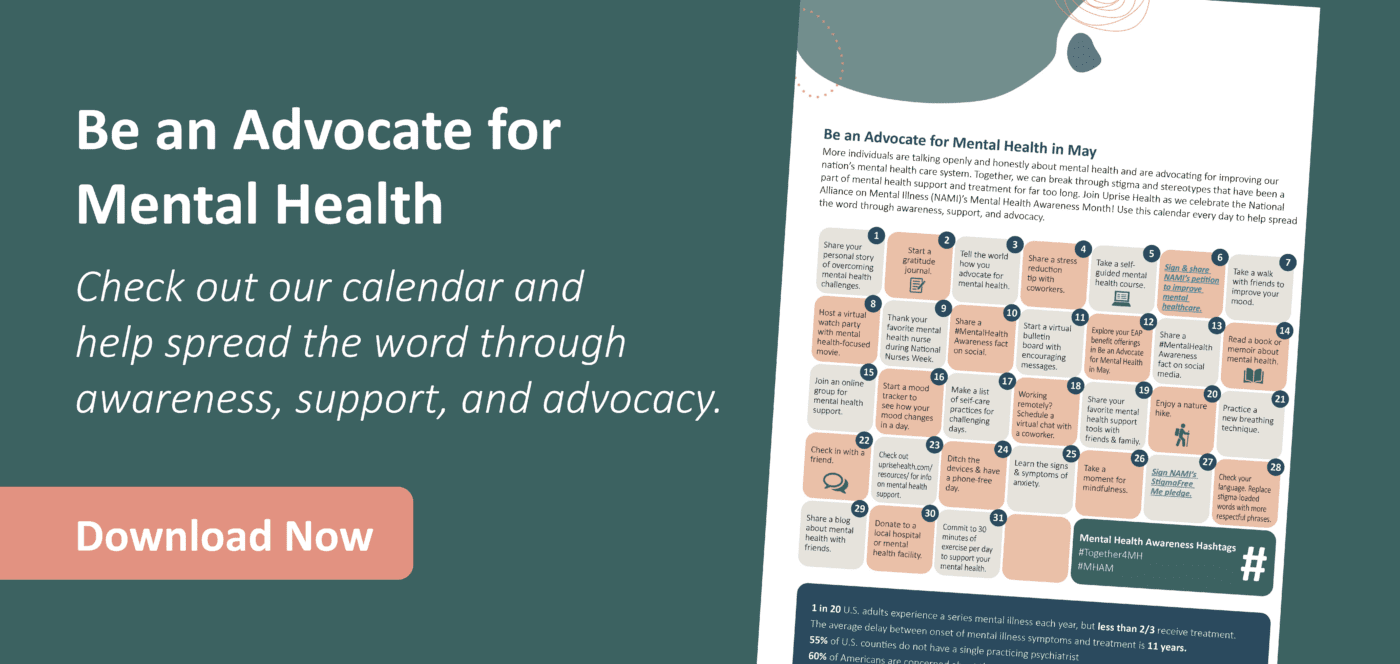May is Mental Health Awareness Month. Mental Health Awareness Month was started in 1949 by Mental Health America (MHA), which was then known as the National Association for Mental Health. The purpose of Mental Health Awareness Month is to educate and raise awareness about mental illness, strategies for improving and working on mental health and wellbeing, and stigma around mental health conditions.
This year’s MHA theme for Mental Health Awareness Month is “Back to Basics,” and the goal is to “provide foundational knowledge about mental health & mental health conditions and information about what people can do if their mental health is a cause for concern.”1
Uprise Health is dedicated to improving mental health by offering tools and services that are easy to use and effective. To help spread awareness during Mental Health Awareness Month, we are sharing valuable information and resources related to mental health and mental illness.
Facts about Mental Health and Mental Illness
- 1 in 5 American adults experience some form of mental illness.2
- 14.2 million American adults live with a serious mental illness.2
- Anxiety is the most common mental health condition in America—18% of adults have an anxiety disorder.3
- Depression is the leading cause of disability worldwide.4
- 37% of the US population live in areas experiencing mental health professional shortages.5
- Global prevalence of anxiety and depression increased by 25% during the first year of the COVID-19 pandemic.6
Common Myths about Mental Health and Mental Illness
- Myth: “Mental health problems will not affect you or your family.”
Mental health conditions are quite common, and statistically, everybody has a close friend or family member that has a mental health condition. - Myth: “Children do not struggle with mental health.”
50% of all mental health conditions show signs before a child turns 14 years old. About 75% of mental health conditions start before a person turns 24.7 - Myth: “People’s choices and/or character flaws are the cause of mental health problems.”
Mental health problems have many contributing factors including biological factors (genetics, physical illness or injury, brain chemistry), trauma, abuse, environmental impact (pollution, green space, housing conditions), and stressful life situations. Mental illness is not caused by being lazy, stupid, or incapable. - Myth: “People can just snap out of mental health conditions.”
In certain instances, people with a mental health condition can recover completely. In other instances, a person with a mental health condition might not recover but can find treatments that improve their symptoms and quality of life. However, a person cannot just snap out of a mental illness. - Myth: “People with mental health conditions are unproductive, cannot work, and do not contribute to society.”
Most people with a mental health condition work. Employment rates range between 55-70%.8 Government and employers can also work to implement policies and work conditions that would better support diversity, equity, and inclusion. Some people with mental illness cannot or do not work, but that does not mean they are not contributing, valuable members of society. No one’s worth should be married to employment or production. Individuals have inherent worth and dignity. - Myth: “Only people with serious issues need therapy, counseling, or coaching.”
False! We all could benefit from therapy or coaching. It turns out that getting support, asking for help, and getting an outside perspective is beneficial for growth. If more people went to counseling earlier, then that could help prevent mental health conditions from developing further. Asking for help is a sign that you are strong, willing to do something that is uncomfortable, and willing to invest in yourself and improve. - Myth: “People with a mental health condition are violent. Or major violence is caused by people with a mental illness.”
Statistically, people with mental health conditions are no more likely to be violent than people without mental health conditions. Only 3-5% of violent acts can be attributed to people living with a serious mental illness. A person with a mental illness is significantly more likely to be a victim of violence rather than a perpetrator.9
Resources about Mental Health
We have said it before, and we will say it again, ask your EAP or mental health provider for resources. It might seem obvious, but we have so many resources that we are excited to share with you! Uprise Health creates a substantial number of educational materials covering a wide range of mental health topics. We also offer coaching, counseling, and CBT-based courses to help our members cope with mental health concerns and build wellbeing skills. Read more about how our mental health coaching and counseling can help.
Aside from your EAP, here are a few other specific organizations that have valuable resources available:
- If you are suicidal, please reach out to National Suicide Prevention Lifeline.
- Crisis help line is available for people struggling with a crisis.
- SAMSHA’s disaster distress line provides crisis counseling and support to people that are distressed because of a natural or human-caused disaster.
- National Institute of Mental Health
- Mental Health America
- Mentalhealth.gov
- Mental News Today offers a comprehensive list of available resources.
- Daily Strength: Online peer support group forum
Resources
- https://www.mhanational.org/mental-health-month
- https://www.nimh.nih.gov/health/statistics/mental-illness
- https://adaa.org/understanding-anxiety/facts-statistics
- https://www.who.int/news-room/fact-sheets/detail/depression
- https://usafacts.org/articles/over-one-third-of-americans-live-in-areas-lacking-mental-health-professionals/
- https://www.who.int/news/item/02-03-2022-covid-19-pandemic-triggers-25-increase-in-prevalence-of-anxiety-and-depression-worldwide
- https://www.ncbi.nlm.nih.gov/pmc/articles/PMC1925038/
- https://blogs.worldbank.org/health/shining-light-mental-illness-invisible-disability
- https://www.mentalhealth.gov/basics/mental-health-myths-facts






